Why Explore Lesser-Known Historic Sites in Staffordshire?
Exploring Staffordshire's lesser-known historic sites allows you to uncover hidden gems and forgotten tales. Visit Himley Hall, associated with Guy Fawkes, or marvel at the unique rock houses on Kinver Edge. Explore Charles Darwin's ancestral home and sacred medieval wells. These sites reveal hidden architectural wonders and connect you to local legends like Jenny Greenteeth. Experience the rich blend of history and folklore, from unrecorded historical events to eerie folk tales. You'll gain a deeper insight into Staffordshire's cultural heritage and its secrets, enhancing your appreciation for the region's significant yet often overlooked history. There's much more to discover.
Key Points to Remember
- Explore unique architectural gems that combine historical and modern elements.
- Unearth hidden stories and local legends that enhance Staffordshire's cultural heritage.
- Visit important historical sites like the medieval holy wells and Darwin's ancestral home.
- Discover spooky folklore locations such as the Stone Chasm with Jenny Greenteeth.
- Take a trip to forgotten monuments and ancient ruins that provide a peek into Staffordshire's history.
Hidden Gems of Staffordshire
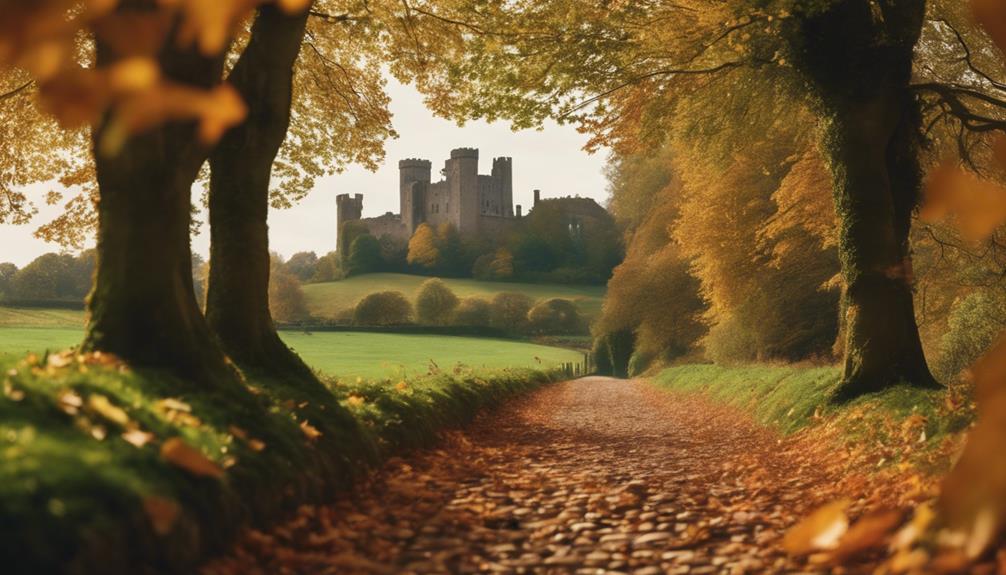
When you're exploring Staffordshire, don't miss out on hidden gems like Himley's historic link with Guy Fawkes and the unique rock houses at Kinver Edge. These sites are perfect for uncovering forgotten tales and appreciating architectural wonders.
Himley Hall, once a royal hunting lodge, has an intriguing past. It's said that Guy Fawkes, of the Gunpowder Plot fame, may have visited here. Walking through the grounds, you can sense the unearthed legends that add a layer of mystery to your visit.
Kinver Edge offers another slice of history with its rock houses. These sandstone caves were homes to families until the 1960s and are considered hidden treasures in Staffordshire. As you explore these unique dwellings, you'll marvel at how they were carved directly into the rock face. The ingenuity and resilience of the people who lived here are palpable.
These hidden gems provide a sense of belonging, connecting you to the past in a tangible way. Discovering these sites offers not just a journey through history, but a connection to the stories and people who shaped the region.
Uncovering Forgotten Stories
When you explore Staffordshire's less well-known historic sites, you uncover hidden architectural gems that tell the stories of the past.
You'll find local legends unearthed and untold historical events revealed, adding layers of intrigue to the region's heritage.
These forgotten stories enrich your understanding of Staffordshire, offering a fresh perspective on its diverse and compelling history.
Hidden Architectural Gems
Exploring Staffordshire's hidden architectural gems reveals a wealth of forgotten stories and remarkable history. When you investigate these secret hideaways, you'll discover ancient structures that recount tales of the past.
For example, visit the house where Charles Darwin's grandfather developed influential ideas. This overlooked masterpiece unveils hidden stories about the origins of evolutionary theory, providing a peek into the past that few have the chance to see.
Another treasure is the stone throne, offering stunning views of the Peak District. This landmark, often underestimated, stands as a tribute to the area's natural beauty and historical importance. You can sit where many others have sat before you, contemplating life's mysteries while admiring the breathtaking scenery.
Make sure not to overlook the medieval holy well of St. Chad. This concealed historical gem is steeped in legend and offers a unique insight into Staffordshire's religious past. The well's ancient waters were once believed to possess healing powers, making it a significant place of pilgrimage.
Lastly, explore the eerie stone chasm and the reimagined Brown Betty Teapot. Both locations have been restored with historical features, blending the past with modern intrigue. Each spot has its own fascinating history, waiting for you to delve into and reveal its secrets.
Local Legends Unearthed
As you roam through Staffordshire, you'll come across local legends like the malevolent mermaid Jenny Greenteeth, whose spooky tale lingers around a haunting stone chasm. This spine-chilling story, passed down through generations, recounts a mermaid who preys on the unsuspecting, drawing them to a watery demise.
Such hidden mysteries make Staffordshire a treasure trove for those eager to uncover forgotten tales.
Venturing further, you may find yourself at sites steeped in enigmatic history, each with its own story to share. These local legends are more than just tales; they are threads that form the fabric of Staffordshire's rich cultural heritage.
Pause for a moment to heed the whispers of the past, and you'll feel a connection to the land and its inhabitants.
Exploring these locations, you become part of a community that cherishes its heritage and the hidden mysteries that accompany it. From eerie chasms to ancient ruins, Staffordshire beckons you to stray from the well-trodden path.
Seize the opportunity to unearth forgotten stories, enhancing your appreciation of this historic county. It is through these lesser-known narratives that you truly grasp the depth and character of Staffordshire.
Unrecorded Historical Events
Uncover untold historical events in Staffordshire that reveal a tapestry of forgotten stories waiting to be explored. One such story involves a massive non-nuclear explosion at a stone chasm, an event that left behind more questions than answers. This forgotten mystery invites you to investigate its hidden narratives and ponder the impact it had on the local community.
Have you heard of Jenny Greenteeth? This malicious mermaid legend resides in a mysterious pool, adding a chilling layer to Staffordshire's folklore. Her tale, though lesser-known, captures the imagination and enriches our understanding of the region's cultural history.
Staffordshire also boasts a former military training ground, possibly linked to J.R.R. Tolkien's inspiration for his writings. Exploring this site uncovers not just historical significance but a connection to literary heritage.
Don't miss the monument honouring British men drafted into coal mines during WWII. This tribute stands as a poignant reminder of their sacrifices and the hidden narratives of wartime labour.
Haunting Legends and Folklore
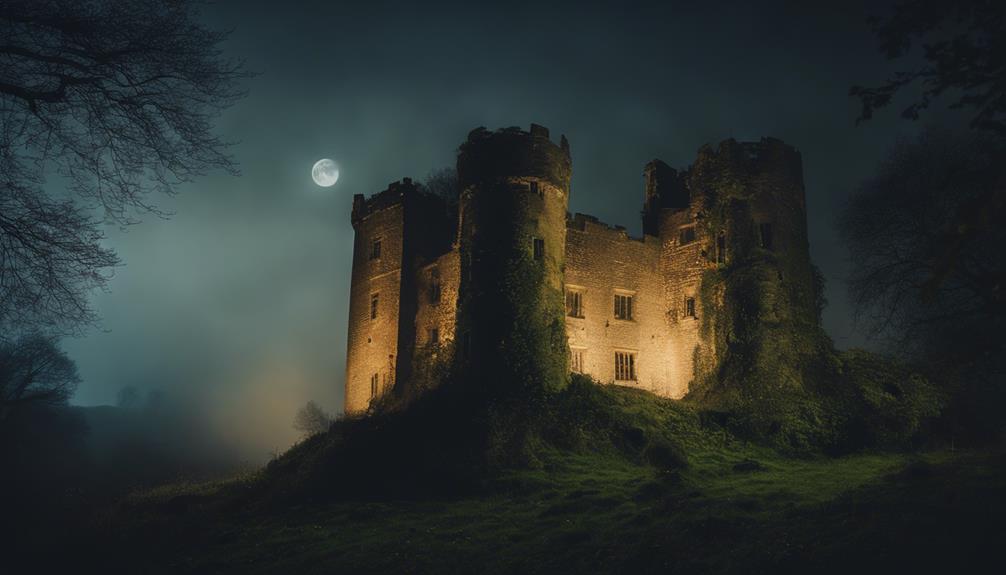
Venture into Staffordshire's eerie stone chasm, where the legend of Jenny Greenteeth, a malevolent mermaid, will send shivers down your spine. Local folklore mysteries and eerie encounters surround this chilling location. According to the legends, Jenny Greenteeth lurks in the waters, waiting to drag unsuspecting victims to a watery grave. This mermaid legend adds layers of historical intrigue to the already ominous site.
The chasm, steeped in folklore mysteries, isn't just about eerie encounters with mermaids. It has a rich history that includes being a former military training ground. Some even believe that this very place inspired elements in J.R.R. Tolkien's works. As you walk through, you can almost feel the whisper of past events and the weight of its dark history.
Beyond the haunting legends, Staffordshire is home to other unique historical landmarks. From the house where Charles Darwin's grandfather developed influential ideas to the medieval holy well of St. Chad, each site holds its own story. Exploring these lesser-known places offers a sense of belonging, connecting you to a tapestry of history and legend that's both fascinating and haunting.
Sites of Explosive History
Beyond eerie legends and folklore, Staffordshire's history is punctuated by significant events such as one of the largest non-nuclear explosions in history. This explosive landscape serves as a memorial to the hidden tragedies that have influenced the county. You can visit the RAF Fauld explosion site, which took place in 1944. This incident, triggered by an accident at an underground munitions storage facility, led to a colossal explosion that created a crater that can still be seen today.
Exploring this location provides a rare insight into a dramatic moment in Staffordshire's history. You are not just observing a physical terrain but stepping back in time to a period where everyday life was abruptly and violently disrupted. To gain a better understanding of this event, here is a brief comparison:
| Aspect | Details |
|---|---|
| Date of Explosion | 27th November 1944 |
| Cause | Accidental detonation of stored munitions |
| Immediate Impact | Crater 100 feet deep, 250 yards wide |
| Casualties | Approximately 70 people lost their lives |
Military Bases and Literary Connections
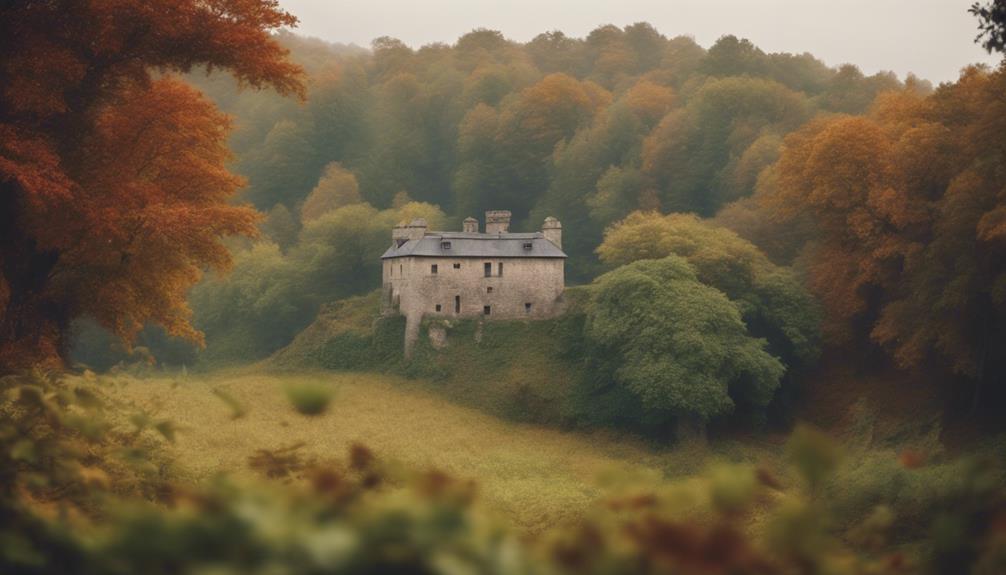
Explore Staffordshire's former military training grounds not only shaped soldiers but also possibly inspired the imaginative landscapes in J.R.R. Tolkien's works. When you walk through these historical sites, you're stepping into places rich with military heritage. These grounds, used extensively during various conflicts, provide a tangible connection to the past, offering you a deeper understanding of the sacrifices made by those who trained here.
One notable site is Stone Chasm, known for a massive non-nuclear explosion and the eerie legend of Jenny Greenteeth, a malicious mermaid. Visiting such places allows you to appreciate their historical significance and hidden stories. Additionally, there's a monument dedicated to British men drafted into coal mines during WWII, highlighting often overlooked aspects of the region's history.
These military grounds might've also served as literary inspirations for Tolkien, who spent time in Staffordshire. The landscapes, with their mix of natural beauty and historical weight, could easily fuel the creation of Middle-earth. By exploring these sites, you're not just learning about history but also connecting with the roots of some of the world's most beloved literature.
Darwin's Ancestral Home
When you visit Darwin's ancestral home, you're stepping into a place rich with family history and architectural significance.
This historic site isn't just where Charles Darwin's grandfather was born; it's where the intellectual roots of the Darwin family took hold.
The house and its grounds offer a unique glimpse into the past, illustrating how the family's legacy began in Staffordshire.
Darwin Family History
Discover the rich history of the Darwin family by visiting their ancestral home in Staffordshire, where groundbreaking scientific ideas first took root. This house isn't just a building; it's a tribute to the Darwin family legacy. Here, Charles Darwin's grandfather, Erasmus Darwin, formulated some of the early ideas that would later influence Charles's evolutionary theories.
By exploring this home, you gain a deeper understanding of the historical significance and Staffordshire connections that shaped the Darwin family. Imagine walking through the same halls where discussions that would change the course of science took place. The house offers a unique glimpse into the environment that nurtured one of the most influential scientific minds.
| Aspect | Details |
|---|---|
| Darwin Family Legacy | Groundbreaking scientific ideas |
| Ancestral Home | Erasmus Darwin's influential discussions |
| Evolutionary Theories | Roots of Charles Darwin's ideas |
| Historical Significance | Staffordshire's role in shaping the Darwins |
Visiting this historic site, you don't just learn about the past; you become part of a community that values the pursuit of knowledge and the importance of history. This connection to the Darwin family's legacy makes the ancestral home in Staffordshire a must-visit for anyone interested in the roots of evolutionary thought.
Architectural Significance
Beyond its historical significance, Darwin's ancestral home in Staffordshire captivates visitors with its unique architectural features that also played a role in shaping his upbringing. This house isn't just a monument to history; it's a vital piece of architectural heritage that influenced Darwin's early years.
As you walk through the rooms and corridors, you'll notice the intricate designs and period-specific craftsmanship that make this house a standout.
Every corner of the home whispers stories of the past, offering a tangible connection to the environment that sparked Darwin's evolution inspiration. The high ceilings, detailed mouldings, and expansive windows not only reflect the architectural trends of the era but also provide insights into the lifestyle and intellectual milieu that shaped one of history's greatest minds.
Visiting this historical landmark lets you step into a world that profoundly influenced the development of evolutionary theory. The architectural heritage preserved within these walls serves as a reflection of the environment that nurtured Darwin's curiosity and intellect.
Sacred Medieval Wells
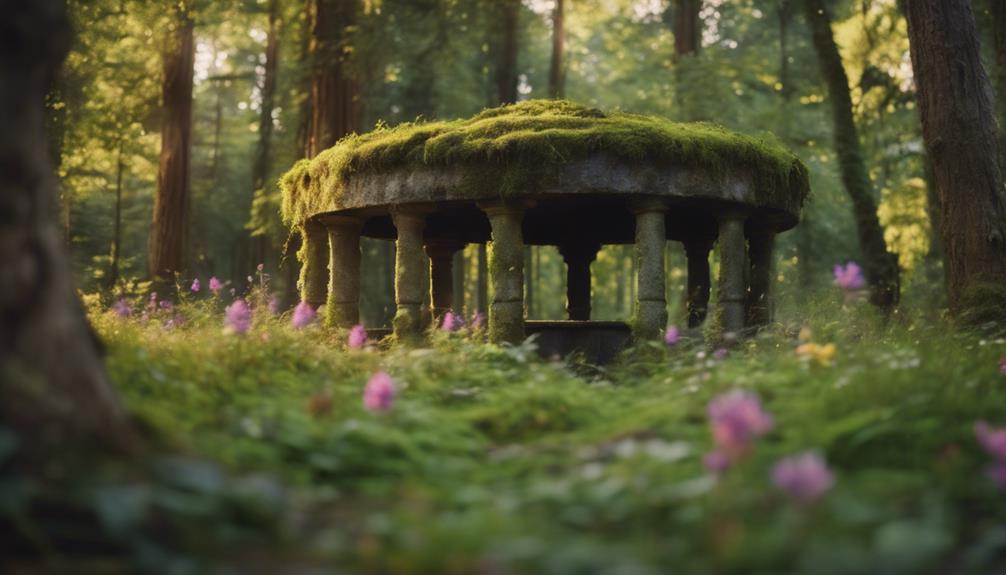
Nestled within Staffordshire's landscape, sacred medieval wells like the historic holy well of St. Chad offer a fascinating glimpse into ancient religious practices. These wells are steeped in cultural significance, believed to possess healing properties that attracted pilgrims seeking blessings and relief. When you visit these sites, you're not just exploring history; you're connecting with ancient traditions that have shaped the region's spiritual and cultural identity.
Discovering the medieval holy wells scattered across Staffordshire allows you to investigate their unique histories and folklore. Each well tells its own story, offering a window into the past where communities gathered, rituals were performed, and faith was reaffirmed. The well of St. Chad, for example, is renowned for its supposed curative powers, drawing countless visitors over the centuries.
Exploring these lesser-known sites gives you a deeper understanding of Staffordshire's rich historical and spiritual heritage. It fosters a sense of belonging as you uncover the region's enduring legacy. By visiting these sacred wells, you become part of a tradition that has connected people to this land for generations, making your journey both meaningful and enriching.
Heritage Through Architecture
When exploring Staffordshire, you'll find its rich heritage reflected in the unique architecture of medieval gems and hidden historical treasures. From stately homes to ancient castles, these structures reveal stories of the county's past and cultural significance.
Visiting landmarks like Stafford Castle or the Ancient High House offers a glimpse into the architectural diversity that makes Staffordshire renowned for its history and heritage.
Medieval Architectural Treasures
Staffordshire's medieval architectural gems, such as Tamworth Castle and Stafford Castle, offer a captivating journey through history with their rich heritage and stunning designs. These sites are not just buildings; they are gateways to medieval mysteries and ancient secrets.
Tamworth Castle, with its blend of history and live events, has a TripAdvisor Traveller Rating of 684 reviews, demonstrating its widespread appeal. As you explore its halls, you will discover historic charm and architectural wonders that transport you back in time.
Similarly, Stafford Castle's impressive motte and bailey system and expansive grounds invite you to explore its scenic beauty and immerse yourself in its storied past. The castle's picturesque setting makes it a perfect spot for you to connect with history and nature simultaneously.
In addition to these castles, Staffordshire also boasts the Ancient High House, showcasing different historical periods through its majestic architecture. This site provides you with a broader understanding of the region's historical significance.
Furthermore, Boscobel House and Moseley Old Hall offer well-preserved examples of historical architecture, each with its own fascinating stories. These sites offer a sense of belonging and connection to the past, enriching your understanding of medieval heritage.
Hidden Historical Treasures
You will discover a wealth of hidden historical treasures in Staffordshire, each offering unique architectural insights and a rich heritage waiting to be explored. Venturing off the beaten path, you will uncover stories and histories that are not widely known or celebrated, revealing the region's fascinating past beyond its well-known landmarks.
From ancient ruins to forgotten monuments, Staffordshire's lesser-known sites provide a deeper understanding of the county's cultural heritage. These hidden gems are perfect for those who seek a sense of belonging through cultural exploration and historical mysteries. Imagine walking through these treasures and experiencing history firsthand:
- Ancient Ruins: Picture crumbling castles and abbeys, their stones whispering tales of medieval life and long-forgotten events.
- Forgotten Monuments: Think of statues and memorials that have stood the test of time, silently commemorating local heroes and significant events.
- Architectural Marvels: Envision unique buildings with distinct designs that reflect the architectural trends of their respective eras.
Exploring these hidden historical treasures in Staffordshire not only enriches your knowledge but also connects you to the local heritage in a profound way. So, step off the main tourist path and investigate the lesser-known wonders that this charming county has to offer.
Rediscovering Cultural Treasures
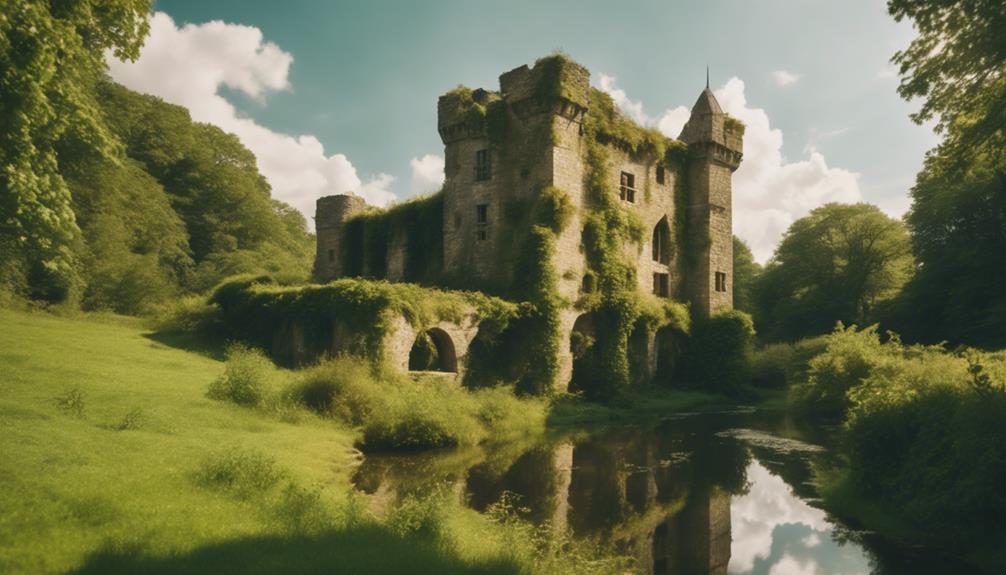
Embark on a journey to uncover Staffordshire's hidden historical gems, each with a unique story waiting to be told. Explore cultural preservation and historical exploration by visiting places like the stone chasm, home to the legend of Jenny Greenteeth, a malicious mermaid. This site isn't just a natural wonder but a piece of local folklore that enriches your understanding of the region's heritage.
You'll also find the site of one of the largest non-nuclear explosions in history, a location steeped in English legend and mystery. This hidden gem provides a vivid picture of the past, enhancing your heritage appreciation through local storytelling. Each visit brings to life the stories that are often overlooked in mainstream history.
At a former military training ground, possibly inspiring J.R.R. Tolkien's legendary works, you can connect with the literary heritage of Staffordshire. Discover monuments like the one commemorating British men drafted into coal mines during WWII, highlighting a forgotten chapter of the area's history.
Unique Historical Experiences
Explore the unique historical experiences that Staffordshire has to offer, each site presenting a fascinating chapter of the past. You'll uncover forgotten stories and hidden gems that make you feel like you're part of something special.
- Stone Chasm with Jenny Greenteeth: Immerse yourself in the legend of a malicious mermaid named Jenny Greenteeth. This stone chasm holds eerie tales that have been passed down through generations, making it a must-visit for those who love folklore.
- Non-Nuclear Explosion Site: Visit the location of one of the largest non-nuclear explosions in history. This site isn't only historically significant but also a somber reminder of the past's dramatic events. It's a unique experience that brings to life the stories often left out of mainstream history books.
- Darwin's Grandfather's House: Step into the house where Charles Darwin's grandfather developed influential ideas. This landmark offers a peek into the intellectual atmosphere that shaped one of history's most impactful scientific minds.
From the medieval holy well of St. Chad to the former military training grounds that may have inspired J.R.R. Tolkien, Staffordshire offers a rich tapestry of unique experiences. Each site invites you to become part of its ongoing story.
Frequently Asked Questions
What Are Some Family-Friendly Activities Available at These Historic Sites?
You'll find family-friendly activities such as interactive exhibits that engage children and adults alike. Enjoy picnic areas where you can relax and connect with loved ones, creating lasting memories in the charming historic settings of Staffordshire.
Are There Any Guided Tours Available for These Lesser-Known Locations?
Yes, you'll find guided tours available at these lesser-known locations. Local guides offer enriching insights, making you feel part of the community. Don't miss out on the chance to explore with knowledgeable locals who share your interests.
How Accessible Are These Sites for Travellers With Disabilities?
You'll find many sites in Staffordshire offer wheelchair accessibility and sensory experiences. It's essential to check individual locations for specific accommodations, ensuring everyone feels welcome and included as they explore these hidden historical treasures.
What Is the Best Time of Year to Visit These Historic Sites?
The best time to visit these historic sites is spring or summer. You'll enjoy pleasant weather conditions and vibrant seasonal events. It's a perfect opportunity to connect with fellow history enthusiasts and feel like part of the community.
Are There Any Local Accommodations Near These Historic Sites?
You'll find delightful boutique hotels and friendly countryside inns near these historic sites. These cosy accommodations make you feel right at home, offering a perfect blend of comfort and local charm for an enriching experience.
Conclusion
Exploring lesser-known historic sites in Staffordshire offers you a unique glimpse into the region's rich past. You'll uncover forgotten stories, experience haunting legends, and visit sites with explosive history.
From medieval wells to military grounds and architectural marvels, each site offers a distinct piece of cultural heritage. Rediscovering these hidden gems provides a deeper, more personal connection to history, offering experiences that are both educational and unforgettable.
Don't miss out on these cultural treasures.
